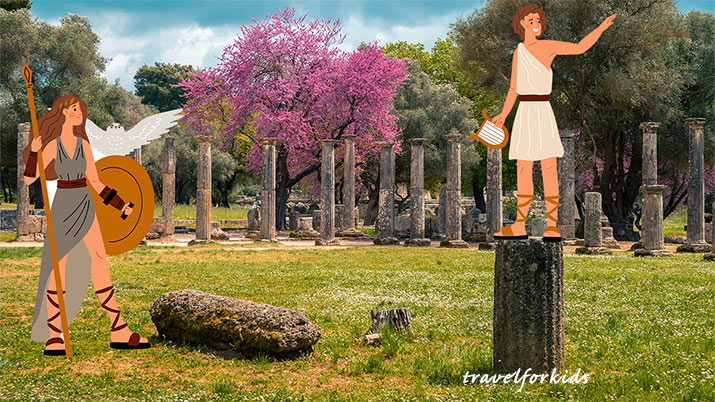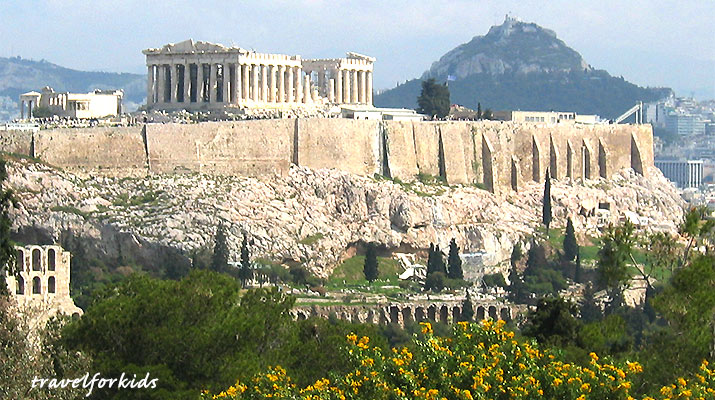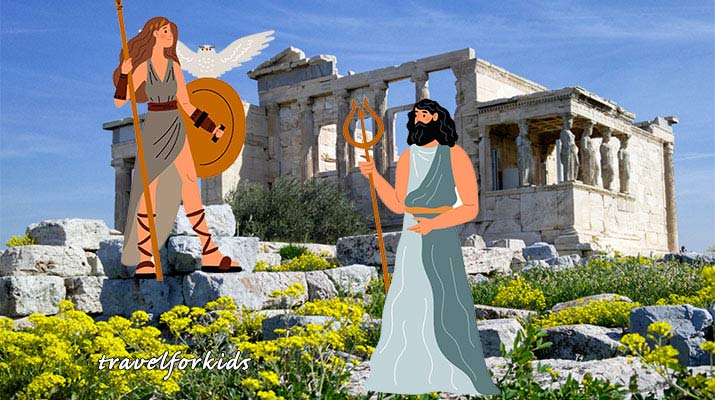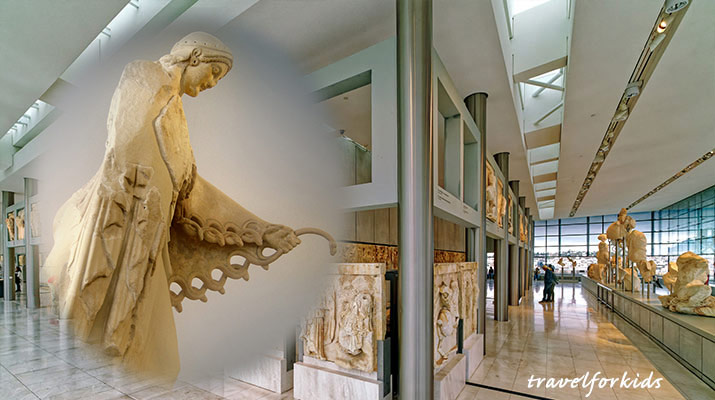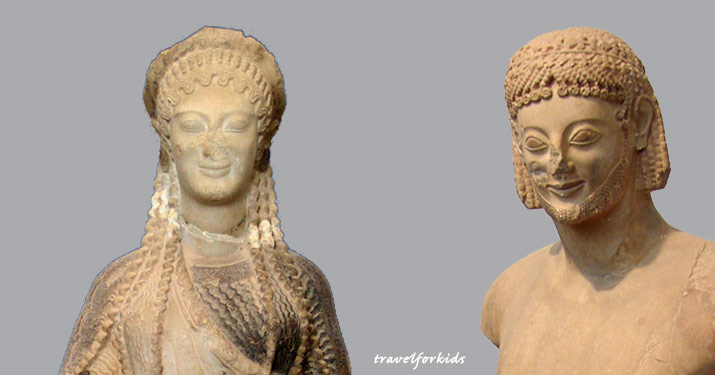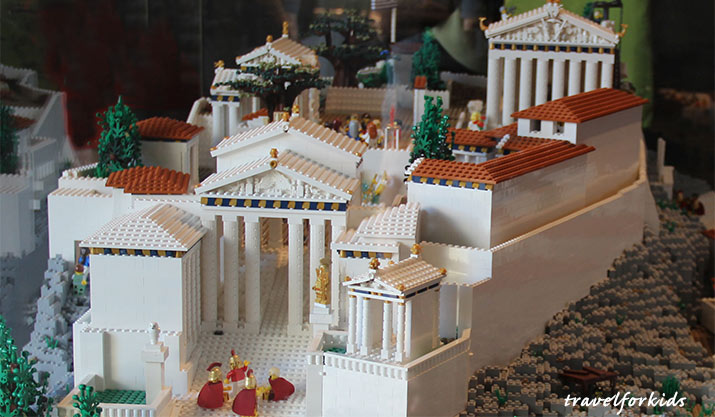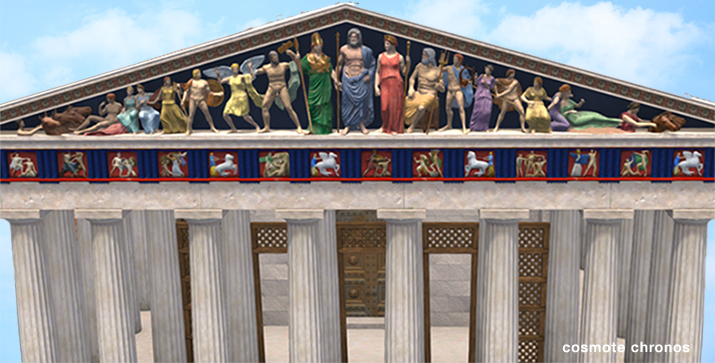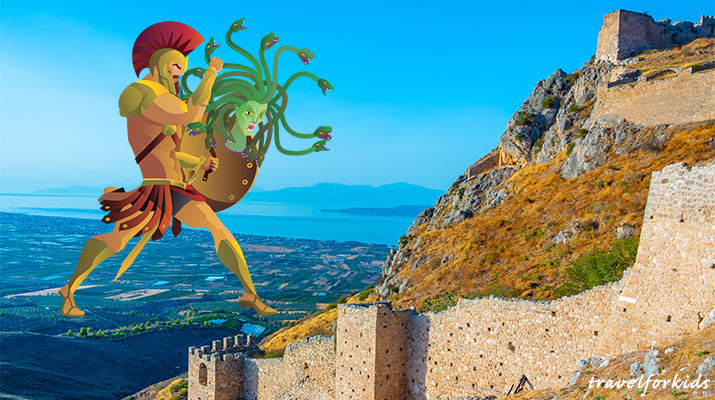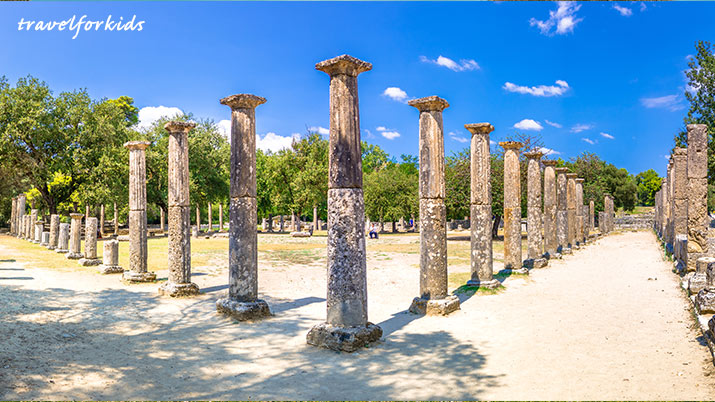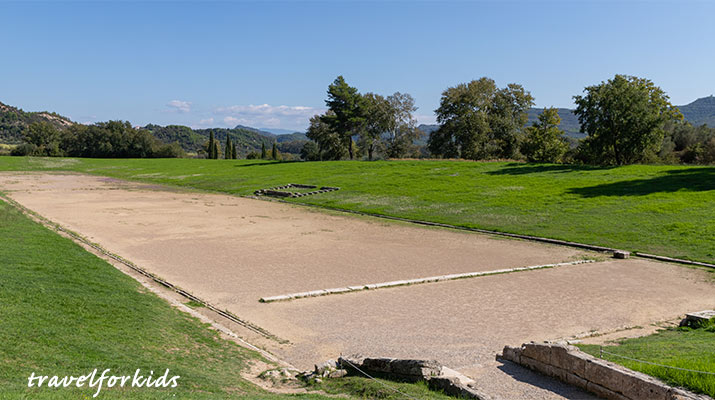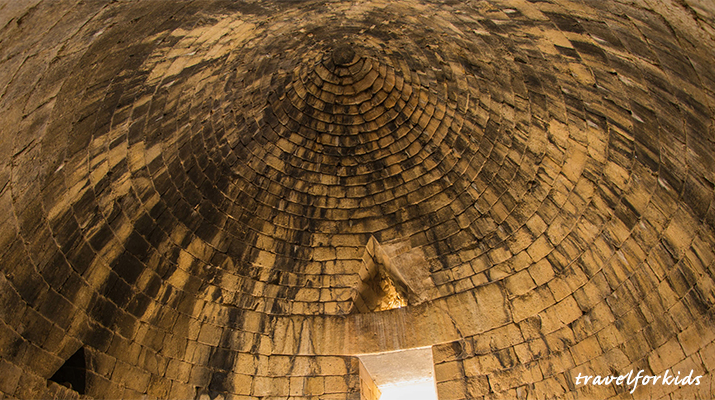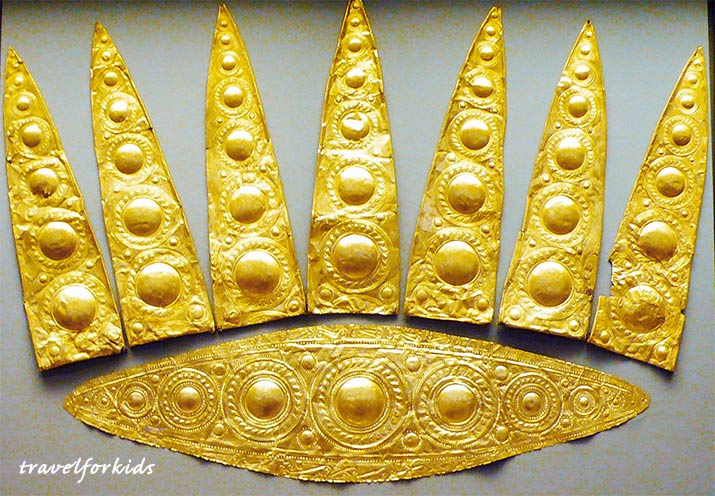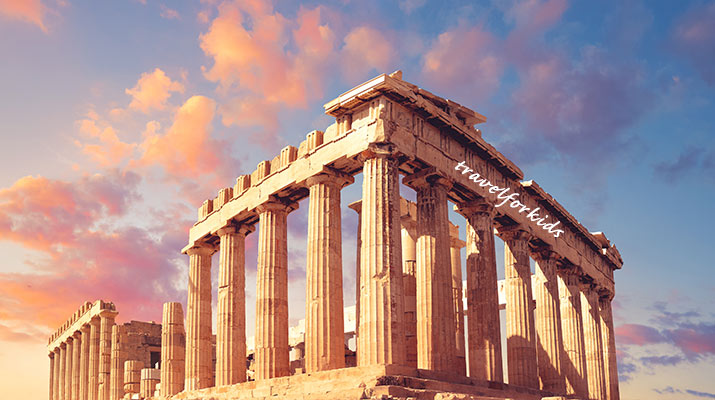One year we hopped on a plane, and spent spring break in Greece.
In spring, Greece has far fewer tourists, trees and flowers bloom in the ruins, days are mild, unlike the heat in summer.
Here are highlights and tips for three favorite sites on our trip – Acropolis in Athens, Olympia, and Mycenae on Peloponnese Peninsula.
The Acropolis
The Acropolis is the highest point in Athens, on this sacred rock plateau are oldest temples and most famous monument, the Parthenon.
Over the centuries, many stone temples, sanctuaries and altars were constructed for Greek gods and goddesses. The complex also had a huge theater for plays, concert hall, sacred caves, protected wells, broad street called the Panatheniac Way for processions during festivals and chariot races.
Inside the Acropolis, temples and shrines were dedicated to Athena, goddess of wisdom and war, daughter of Zeus, and protector of Athens. Each year there were festivals to the gods, the most important one celebrated the birth of Athena. Three temples you’ll see today are dedicated to Athena – the Parthenon, Erectheion and Athena Nike.
The Erectheion is the site of the contest between Athena and Poseidon (god of the sea), to choose the patron of Athens. Poseidon stuck his trident in the ground and water gushed up – only the water was salty. Athena offered an olive tree filled with fruit for food. Judges decided Athena’s gift was most valuable, and declared her the winner. A sacred olive tree grows next to the Erectheion.
The Acropolis Museum
The Acropolis Museum contains amazing sculptures of ancient Greece from more than 2,500 years ago and artifacts from daily life – all excavated from around the Acropolis.
Ground Floor
At the Information Deck, pick up Family Trails, brochures about different routes for kids to explore the museum, especially good for younger kids. Or, download PDFs in advance, before you visit the museum.
Borrow Family backpacks, good for older kids age 8 -12 with a booklet about the Parthenon, children’s map, pouch with toys, puzzle of Parthenon.
In the Archaic Gallery, check out fashions of Kore statues, young women with intricately braided hair, earrings, pleated long dresses, with drapery over the shoulder.
Don’t miss exhibit with three-headed twisty serpent on the right, Heracles on the left, fighting a sea creature, from earlier Parthenon temple.
Look for two statues of Athena (photo at top for museum) fighting a giant, wearing a helmet and gown with marble snakes. Also “Pensive Athena” relief, Athena carries a spear.
On this floor, find a restaurant, restrooms, and Kids Corner.
In Kids Corner, play digital games about myths, and see Acropolis made with Lego bricks!
Third Floor
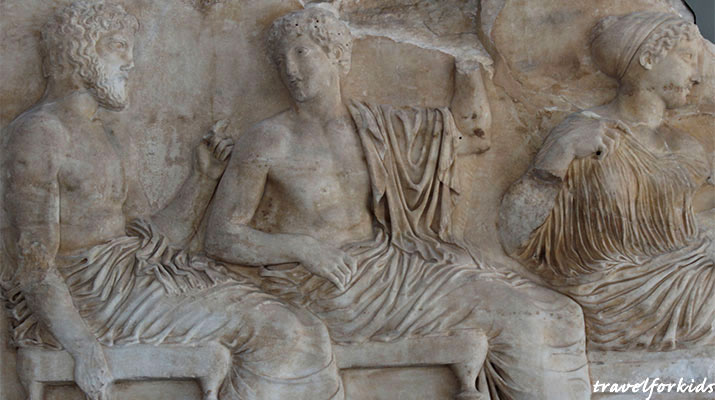
On this floor is the Parthenon Gallery, which has the same dimensions of the Parthenon on the hill above.
Original sculptures, and copies (originals are in the British Museum in London) are arranged to show pediments on east and west sides, and frieze of people and animal figures in a long procession all the way around the temple. Photo above is three gods, from left Poseidon, Apollo, and Artemis.
Start on the west side of the Gallery, this is the way you’ll see the Parthenon when you enter through the Propylaia main gate.
Tip: To find out more about details of the Parthenon sculptures: The Parthenon: Athens and London
Tips for the Acropolis
The Acropolis and Acropolis Museum require separate ticket, buy tickets online, reserve well in advance.
Our recommendation, buy tickets online for the Acropolis, timed entry 8am (early as available). Allow time to explore the Acropolis, take a break for lunch, then return later to visit the Acropolis Museum.
Bring water bottles, wear sun screen and hats. Plateau is covered with dusty, slippery-smooth rocks – wear shoes or sandals with straps. Strollers not allowed.
Inside the Acropolis ticket area, no cafes or lunch options are available.
Acropolis of Athens – This free app provides an excellent introduction to the Parthenon, in particular, 3D images show how sculptures looked in full, interior with gold-covered Athena statue, temple painted in bright colors.
Cosmote Chronos – Apple and Android
Family Tours
The Acropolis was the site of festivals, proccessions, temples and shrines, concerts and theater, but how to make it come alive for kids? Take a private family walking tour with a knowledgeable guide:
Acropolis Tour for Kids
Acropolis for Families Private Tour
Small group treasure hunt, explore the Acropolis to solve a mystery, fun for adults and kids, with fun facts, history, puzzles and games, for kids 8 and up:
The Peleponnese
The Peloponnese peninsula is land of Greek myth and history – Olympia, site of Olympic games, Sparta, Corinth, Mycenae. In the epic poem The Illiad, Paris steals Helen from the king of Sparta, starting the Trojan War. Mycenae was founded by Perseus who killed Medusa the Gorgon, from Corinth is the myth of the magical horse Pegasus, captured by Bellerophon.
To explore the Peloponnese peninsula, you’ll need a car, or a private driver.
Olympia
Olympia was the site of athletic games in ancient Greece, starting in 8th century BC. Every four years, athletes competed in horse and chariot races, boxing, wrestling, and foot races. Sacrifices were offered to Zeus at a great temple (statue of Zeus was a Wonder of the World), and winners of the races crowned with olive wreaths.
Archaeological Museum of Olympia
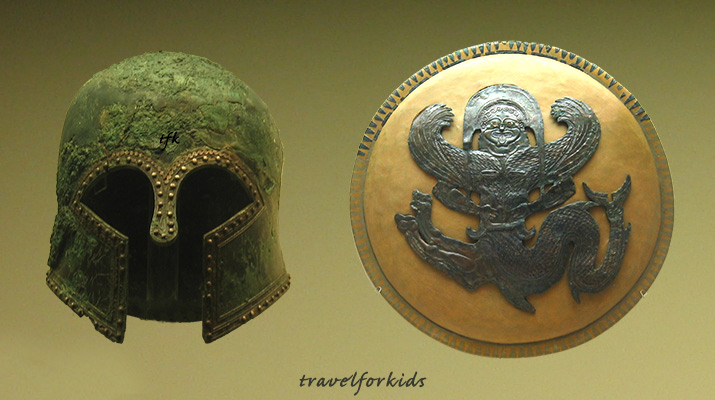
Before going out to the ruins, stop into the museum first. Here you can see a gorgeous collection of artifacts excavated at Olympia – bronze helmets, shields decorated with Gorgons, tiny votive figurines, exquisite statue of Hermes holding the baby Dionysus, sculptures and reliefs from Temple of Zeus, scenes from mythical Labors of Heracles. Later Roman sculpture includes lovely women and a statue of Hadrian.
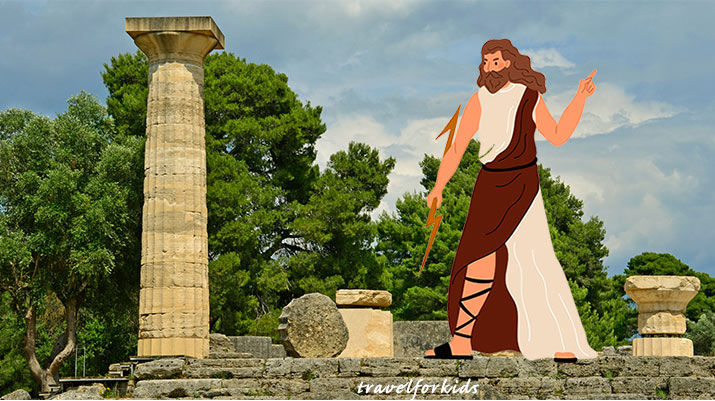
The Temple of Zeus was a wonder of the ancient world, but when Olympia was no longer used for the games, the valuable marble, gold and ivory was pillaged and taken away. All that’s left of the Temple of Zeus is a single high column.
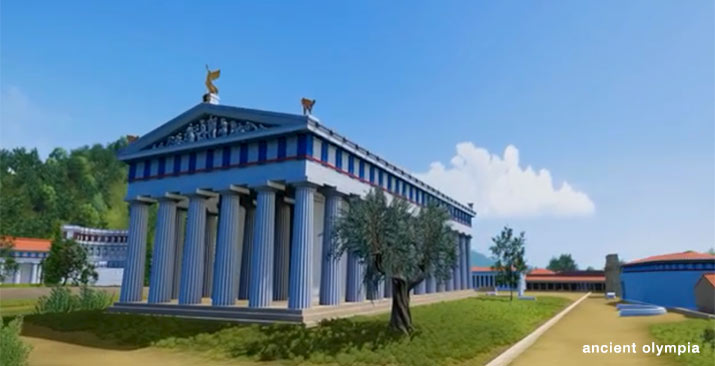
Before exploring the ruins, download this free app: Ancient Olympia, with 3D images that show how Olympia looked thousands of years ago. In addition to a map of the site, reconstruction of the magnificent Zeus statue, temples brightly painted, itinerary of each day of the games, video tour, audio narration.
Ancient Olympia – Apple and Android
After you’ve explored the monuments, head out to the Stadium. It looks familiar, with a long field, and embankment on either side for spectators. (When we visited, group of teenagers ran up and down the length of the field, classmates cheering them on.)
Come to the site early, opens at 8:30am. By 10:00am, crowds from cruise ships will have arrived.
Bring water bottles, sunscreen, hats.
Fun to have a picnic. Also, There’s outdoor cafe on-site with cold drinks, coffee. Also, casual outdoor restaurants are close by to the archaeological site.
Mycenae
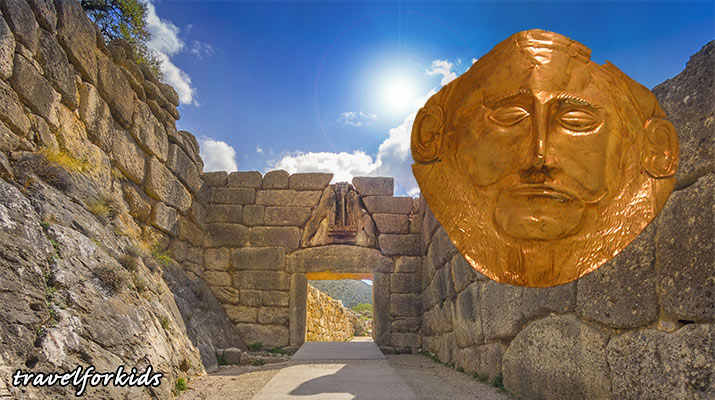
On our spring break trip, Mycenae was our favorite ancient site. Beautifully preserved stone walls, beehive tombs, warren of rooms to explore, a secret cistern, and golden artifacts.
In Greek myths, Perseus killed Medusa and founded Mycenae, the Cyclops built the stone citadel, King Eurystheus assigned Heracles his twelve impossible tasks.
In The Iliad, Homer describes Mycenae as “rich in gold, and it was – gorgeous golden artifacts have been excavated from tombs at Mycenae. Historically, Mycenae was fortified stronghold of Agamemnon, High King of Greece, who led the Greeks in the Trojan War.
Situated on a rocky plateau, the citadel of Mycenae was enclosed in thick stone walls, enter the site through the imposing lion gate.
First stop, make a detour into Grave Circle A. In 1876 was discovered a treasure trove of golden artifacts, including golden masks, jewelry, belts, bracelets, diadems, rings, cups, plus bronze swords and daggers.
Kids will have fun running around the warren of rooms, including the palace, which was originally brightly decorated in red, blue and yellow geometric patterns.
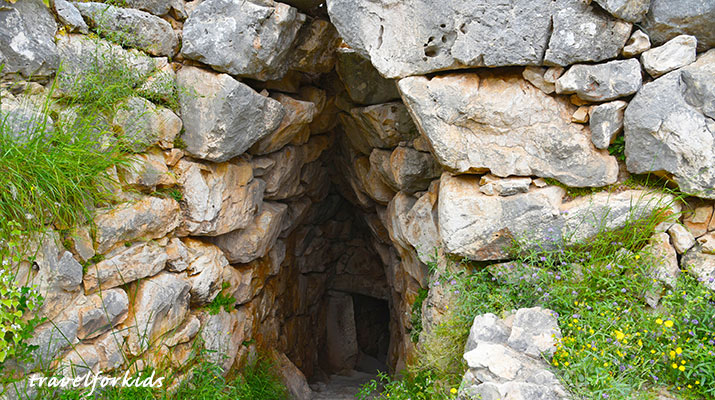
Secret cistern – At the northeast corner of the citadel, there is an entrance to an underground cistern. Water from a spring flowed to the cistern, providing a steady supply of water for people in the citadel.
Bring flashlights to go down the steps that lead to the cistern, steps are worn smooth, careful as you go down.
Outside the citadel walls, two beehive tombs are exceptional.
Treasury of Atreus (Tomb of Agamemnon) is the biggest of all the tombs at Mycenae. Step through the doorway, originally brightly painted and decorated, into a soaring beehive space, cool and dark inside. Contents of the fabulous tomb were looted long ago.
Tomb of Clytemnestra – Another beehive tomb, it was a royal burial (not really for Clytemnestra, wife of Agamemnon), built around 1220 BC, more than three thousand years ago!
Check out the two models of Mycenae, one of the entire walled city, another of the palace alone – the models really help to visualize what the citadel was like.
The museum also has reproductions of golden burial goods from Grave Circle A, golden death mask, two swords, golden diadem and necklace, and a collection of endearing pottery votive figures.
Tip: To see original golden artifacts, visit National Archeological Museum in Athens.
On Travel for Kids, find more fun things to do with kids in Greece, including Crete and Delphi.

